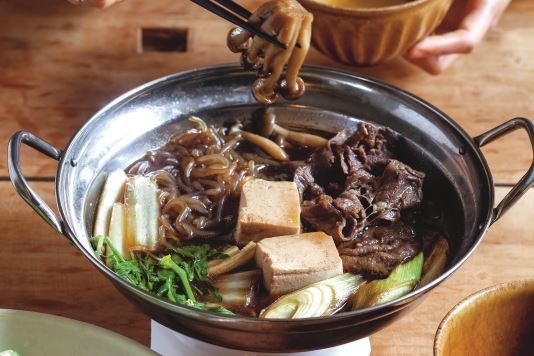Sukiyaki beef hotpot recipe

A healthy Japanese hotpot for the colder months.
This recipe will make extra dashi, which is the stock used as the base for the broth. If you don't want spare, adjust the quantities accordingly so that you only make 200ml, with 2g of kombu and 2g of katsuobushi.
It is easy to remember the quantities of katsuobushi and kombu: use 1% of each to match the quantity of water.
Ingredients
- 1 x 400g (approx) packet shirataki noodles
- 1 pack shimeji mushrooms
- 1 leek (white part only)
- 0.5 bunch shungiku or rocket
- 0.25 Chinese cabbage
- 500 g tofu
- 600 g sliced beef
- 4 extra-fresh organic eggs
- 200 ml dashi (see separate method and ingredients
- 2 packets pre-cooked udon noodles
- 1 x 400g (approx) packet shirataki noodles
- 1 pack shimeji mushrooms
- 1 leek (white part only)
- 0.5 bunch shungiku or rocket
- 0.25 Chinese cabbage
- 17.6 oz tofu
- 21.2 oz sliced beef
- 4 extra-fresh organic eggs
- 7 fl oz dashi (see separate method and ingredients
- 2 packets pre-cooked udon noodles
- 1 x 400g (approx) packet shirataki noodles
- 1 pack shimeji mushrooms
- 1 leek (white part only)
- 0.5 bunch shungiku or rocket
- 0.25 Chinese cabbage
- 17.6 oz tofu
- 21.2 oz sliced beef
- 4 extra-fresh organic eggs
- 0.8 cup dashi (see separate method and ingredients
- 2 packets pre-cooked udon noodles
- 100 ml soy sauce
- 100 ml sake
- 3 tbsp raw sugar
- 3.5 fl oz soy sauce
- 3.5 fl oz sake
- 3 tbsp raw sugar
- 0.4 cup soy sauce
- 0.4 cup sake
- 3 tbsp raw sugar
- 1 l water
- 10 g kombu seaweed
- 10 g katsuobushi (dried bonito flakes)
- 1.8 pints water
- 0.4 oz kombu seaweed
- 0.4 oz katsuobushi (dried bonito flakes)
- 4.2 cups water
- 0.4 oz kombu seaweed
- 0.4 oz katsuobushi (dried bonito flakes)
Details
- Cuisine: Japanese
- Recipe Type: Main
- Difficulty: Medium
- Preparation Time: 60 mins
- Cooking Time: 35 mins
- Serves: 4
Step-by-step
- First, make the dashi. Place the water in a saucepan. Cut the kombu into 2 pieces and add to the water, then leave to soak for at least 30 minutes in the refrigerator. You can do this the night before or a few hours ahead of time.
- Heat the water on a low heat until it just comes to a simmer, about 15 minutes. Don’t let it boil, or the seaweed flavour will be too strong. Take out the kombu just before the stock comes to the boil and add the katsuobushi all at once. Bring to the boil on a medium heat, then turn off the heat immediately. Let it infuse for 10 minutes.
- Strain the dashi into a bowl. Let the dashi drip through, pressing lightly.
- Rinse the shirataki well and drain. Cut into 3 lengths.
- Wash the shimeji and roughly separate them. Cut the leek into 2cm slices on the diagonal. Wash the shungiku, then cut across into 2 sections. Wash the Chinese cabbage and cut into 3 pieces. Cut the tofu into 3cm cubes.
- Place half of the prepared ingredients in a pot, ideally side by side. (If necessary, use a frying pan that doesn’t leave too much space around the ingredients.) Pour over the sukiyaki broth, then cover and cook on a medium heat for about 10 minutes. Add half of the beef.
- Once the vegetables are cooked, bring the pot to the table on a burner. Break the eggs into individual bowls and lightly beat with chopsticks. Let guests serve themselves, dipping the different foods in the beaten egg in their bowl.
- Gradually add more foods to the pot as they run out and repeat the cooking process as you go, according to the appetites of your guests. If there is not enough liquid, add some dashi. Right at the end of cooking (when there are no more ingredients in the sauce), add the cooked udon noodles.
Tokyo Cult Recipes by Maori Murota (Murdoch Books, £20.00). Photography by Akiko Ida and Pierre Javelle.
You might also like:
Comments
Do you want to comment on this article? You need to be signed in for this feature